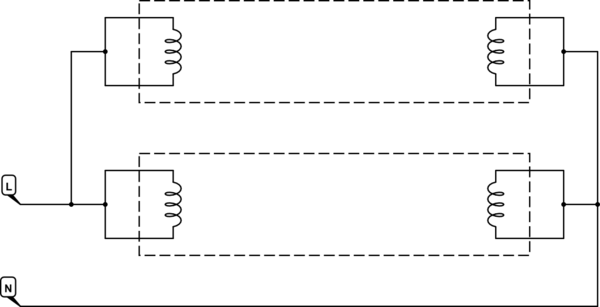Two high-rep answers seem to have made the same misunderstanding, so to clarify:
- My LED replacement tubes DO work with an existing, unchanged magnetic ballast. 2 fluorescent tubes out, 2 LED tubes in, and it works, just like the package says for the LED tubes. That's the baseline.
- The same LED tubes DO NOT work with the second and third circuits drawn below. I've already tried those, with the results described next to the schematics.
Original text follows:
I have a bunch of 4-foot fluorescent fixtures with two tubes each. Two of them died recently. One with bad tubes and one with a bad magnetic ballast. I know it's magnetic because I took it apart and saw just enough "big iron" that wasn't covered by the potting material. I replaced the bad tubes with LED's, and they work wonderfully...or at least they did until I got the idea to rescue the other one with the bad ballast.
Looking at the "classic" schematic for a magnetic ballast with a single tube, I figured that there were 2 possibilities for the LED tubes:
- They're always in the "start" mode, which is supposed to power the heaters at each end of the tube before flyback-striking the arc when the bi-metal starter switch opens, or
- They're always in the "run" mode, which simply puts the line voltage across the length of the tube, with the inductor still in the circuit as a current limit
(same idea as the capacitor in a "transformer-less" power supply, except that the imaginary part has the opposite sign (doesn't matter), and the same inductor also provides the flyback "kick" to get the arc started across the entire tube (that does matter))
I couldn't get a definitive schematic for a 2-tube magnetic ballast, or for the LED tubes, so I just went with the single-tube theory and figured I'd just wire two of those in parallel, permanently in either the "start" or "run" mode:
My first try was "run" mode, since that's how it is when it first receives power (failing that, the high voltage across the starter causes it to close, which switches it to "start" mode):

simulate this circuit – Schematic created using CircuitLab
A single LED tube, with the other socket left empty, flashed briefly and went out. I thought I had fried it, but when I put it back in the fixture that it came out of, that still had a good ballast, it came on again and stayed on.
Well, okay, so hard-wiring it for "run" mode as I understand it to be, minus the inductor, doesn't work. (LED's need a different kind of current control anyway, so the missing inductance shouldn't matter, right?)
So I rewired it to always be in "start" mode instead:

Exact same behavior. Leaving the other socket empty, a single LED tube flashed briefly and went out. Putting it back in the good fixture had it back on again, and staying on.
In both cases, I also tried the other LED tube, with the same results. After both configurations failed with both tubes, I noticed that they were both flickering in the good fixture, as if they were rectified with no filter, when I don't remember them doing that before. I suppose they could have been and I didn't notice, so this might not be an indicator of anything wrong.
I also noticed partway through the test, that the remaining tube in the good fixture was dimmer than when its neighbor was present. Not just the total light output being less because I took out half of the emitters, but the tube that I didn't touch also reduced its own output when its neighbor was removed. So the magnetic ballast is apparently doing something active, even with LED's instead of a 4-foot spark gap.
Since it seems that my understanding is a bit lacking here, what's really going on? Is the LED tube actually using the ballast's inductor as a current-limiting device, like the capacitor in a "transformer-less" power supply? If so, then I probably over-drove it...and triggered a self-protection thing perhaps, because it still worked in a "correct" fixture? I'd be surprised if these cheap things had anything more than the bare minimum required to work at all, but the box does say that they work with most fixtures, so... ¯_(ツ)_/¯
And is it possible to wire this up with no ballast at all, and have a pair of cheap LED tubes work reliably?
(I figured it was worth trying because the tubes are cheap enough to break some in the process of learning.)

